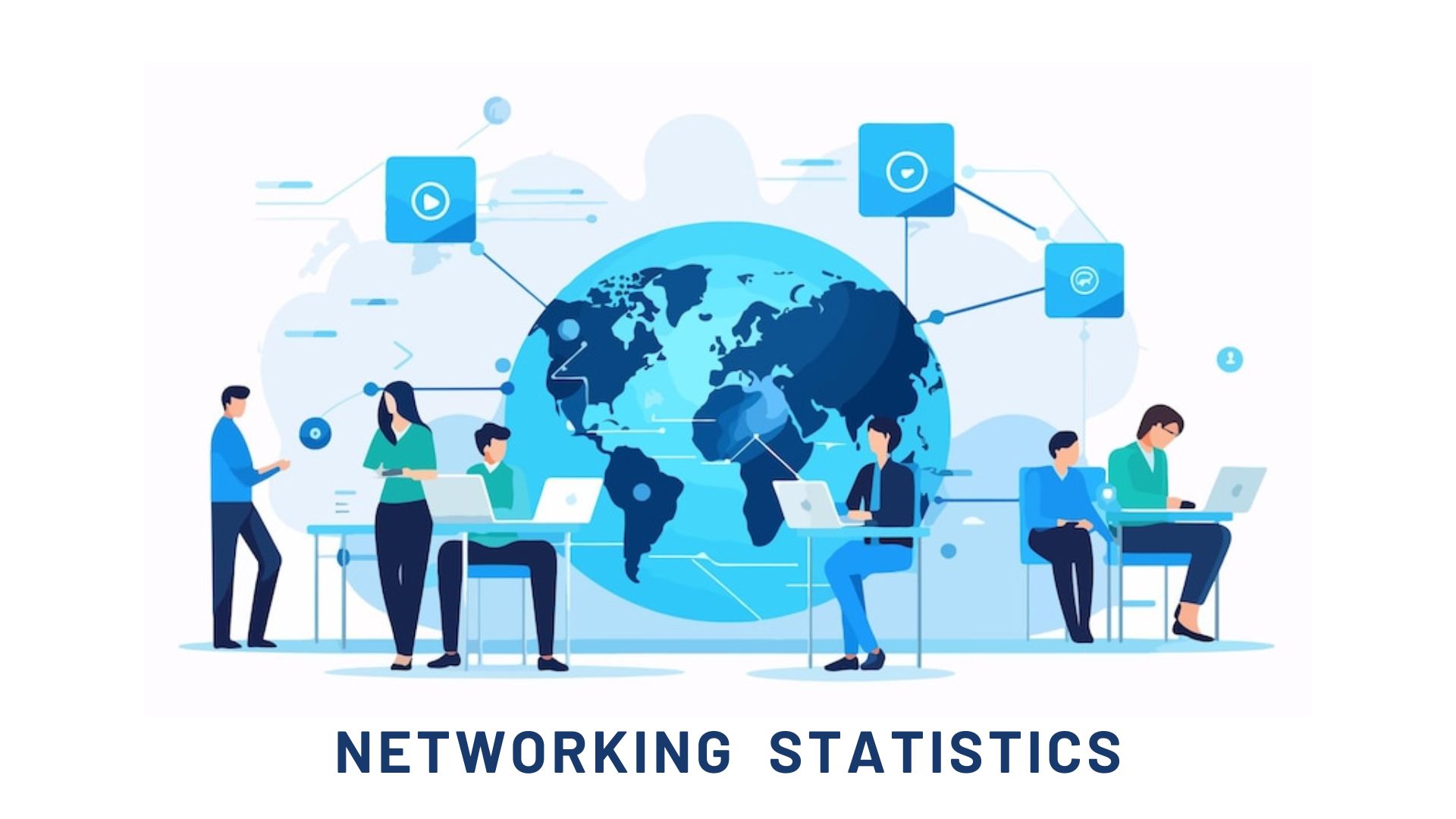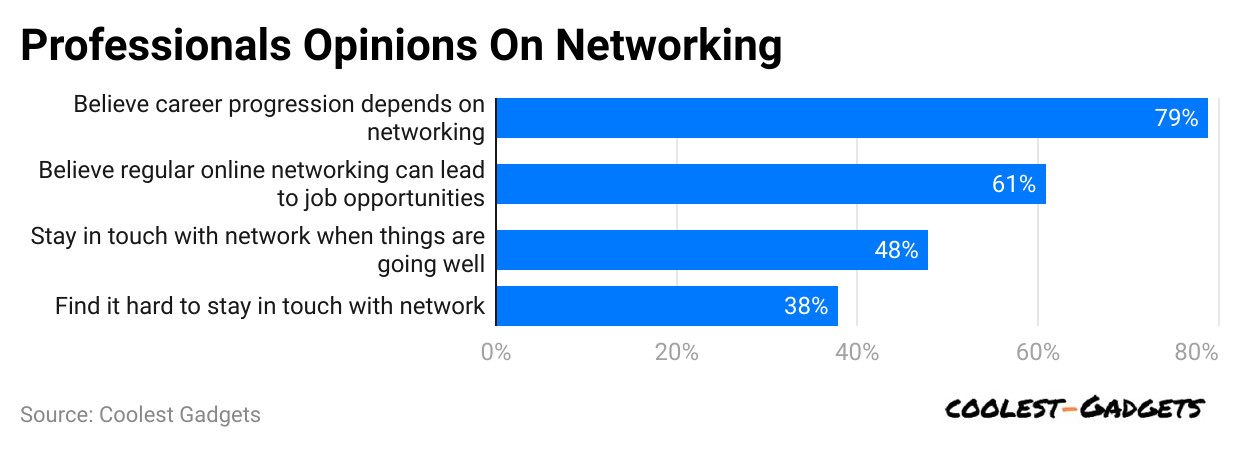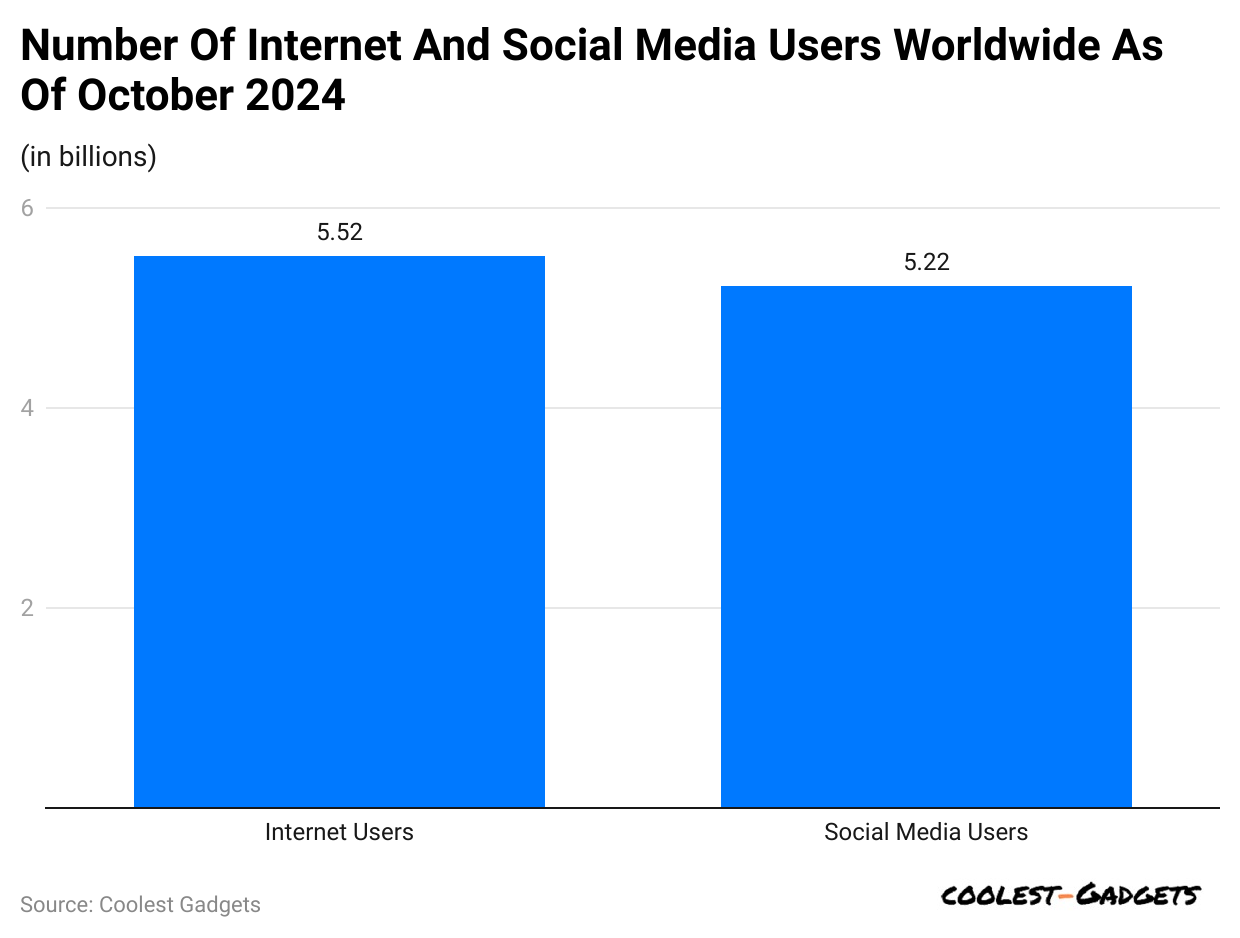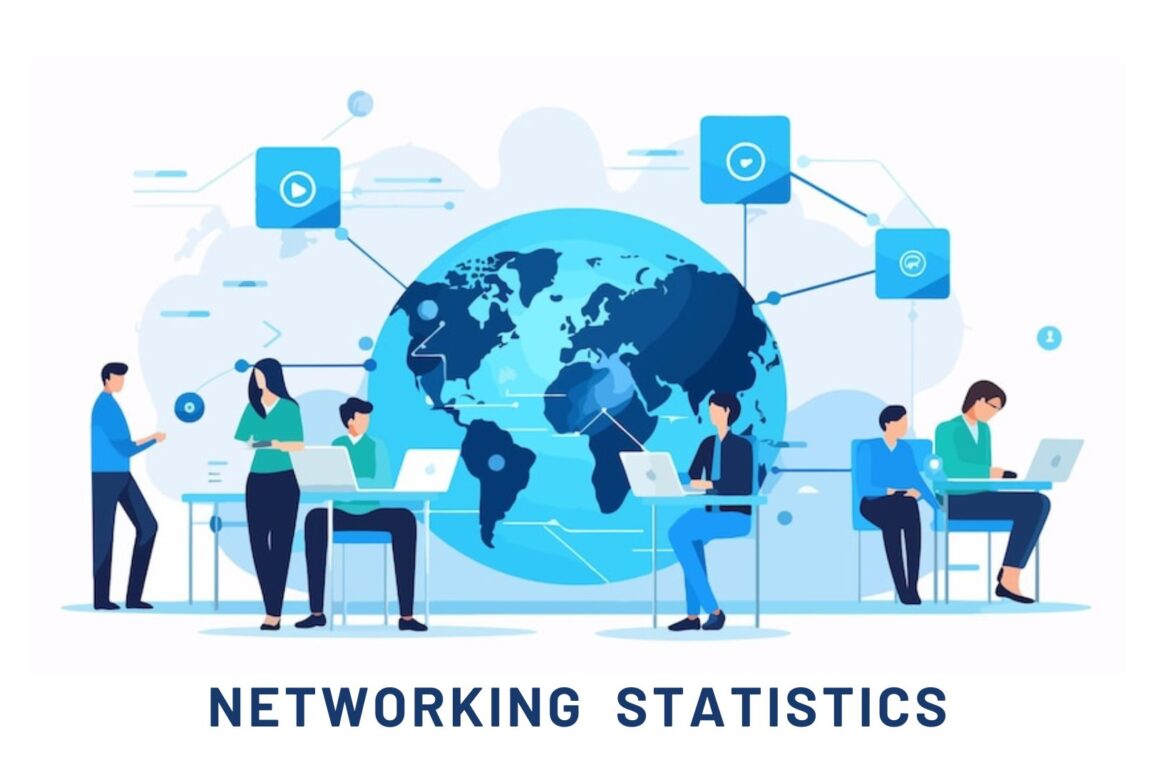
TABLE OF CONTENTS
Introduction
Networking Statistics: Networking helps users understand how computer networks function, how much data is to be handled, and their performance. They help track and analyze network data; we can identify problems like slow connections, security threats, or overloaded systems. This data helps businesses improve their networks and prepare for future needs.
Studying network patterns is an important factor in managing large networks, making sure everything works well, and offering a better experience for users. Whether it’s the internet, a company’s internal Network, or wireless connections, all elaborated statistics in this article are vital for keeping the digital world running smoothly and efficiently. These insights help ensure that networks operate without issues and are ready for any future demands.
Editor’s Choice
- Networking Statistics show networking is important for career growth, as 85% of jobs are filled through connections, and 70% are never listed.
- Meanwhile, 37% of job seekers rely on referrals and their Network to find job opportunities.
- 54% of hires come from employee referrals, making it a powerful strategy.
- As of 2024, around 67 million+ companies are listed on LinkedIn, highlighting its dominance in the professional networking space.
- Moreover, 41% of networkers wish they had more time to network.
- In contrast, approximately 78% of event attendees believe in-person conferences are the best networking opportunities.
- Networking Statistics further report that 49% of professionals cite lack of time as their biggest networking challenge.
- In 2024, around 84% of employers say that referrals reduce the time to fill positions by 62%.
- 80% of job seekers believe networking is crucial for career progression.
- LinkedIn’s revenue reached over USD 15 billion in Q4 2023, illustrating its role in driving professional connections.
General Networking Statistics
- Online networking helps users stay connected and increases the chances of new opportunities or leads by over 50%.
- As of 2024, both men and women have nearly equal chances of finding a job through networking, with men at 26% and women at 25%.
- Around 38% of employees take part in their company’s referral programs at least once during their time there.
- Smaller meetings with around ten people are more effective for networking than larger groups.
- As mentioned in Networking Statistics in 2024, almost everyone agrees that networking is important, and studies show that fewer than 50% maintain contact with their connections.
- Most job positions are filled through personal or professional connections, accounting for 85%.
- Additionally, 60% of people are actively involved in social media platforms.
Networking Statistics by Service Market Revenue

- The Network as a Service market is growing steadily, with a 26.7% annual growth rate from 2022 to 2032.
- The market hit USD 14.6 billion in 2023 and is expected to grow to USD 18 billion in 2024.
- Moreover, in 2024, the WAN and LAN as a Service market is estimated to reach up to USD 11.9 billion and USD 6.1 billion, respectively.
- Revenues grew rapidly, reaching USD 24 billion in 2025, USD 31 billion in 2026, and USD 38.5 billion in 2027, continuing to USD 115.5 billion by 2032.
Social Networking User Statistics




- Networking Statistics show that Facebook was the first social Network to reach one billion accounts and now has around 3,065 million active users, followed by YouTube (2,504 million) and Instagram (2,000 million).
- Meanwhile, in April 2024, other most popular social networks globally by number of monthly active users are WhatsApp (2,000 million), TikTok (1,582 million), WeChat (1,343 million), Facebook Messenger (1,010 million), Telegram (900 million), Snapchat (800 million), Douyin (755 million), Kuaishou (700 million), X/Twitter (611 million), Weibo (598 million), QQ (554 million) and Pinterest (498 million).
Networking Statistics By Professional’s Opinions




- According to 79% of professionals, networking is essential for achieving career success.
- Meanwhile, 61% of people who are involved in networking think regular online networking can create job opportunities.
- Only 48% stay connected with their Network, mostly because they are busy or need more time.
- Despite this, only 38% find it difficult to stay in touch with networking.
Business Networking Statistics
- Around 70% of businesses gained new leads through trade shows for networking purposes.
- 64% of trade show visitors are not existing customers of the businesses there.
- Networking Statistics show that almost 39% of people might leave a business because of its business card design.
- Business relationships can involve clients, customers, partners, and suppliers.
- Networking helps find and retain customers, with in-person meetings closing deals 40% of the time.
- In addition, 75% of customers prefer or need in-person meetings, so not offering them could cost clients in 2024.
- Executives say they would lose 28% of their business if they stopped networking.
- As of 2024, trade shows are an excellent way to network, with 5% to 20% of customers found through them.
- Furthermore, professionals attend trade shows mainly to Network with vendors (48%) and prospects (43%).
In-Person Networking Statistics
- In recent years, over 95% of professionals believe in-person meetings are essential for business success.
- Networking is important because 70% of jobs aren’t advertised, and 85% are filled through referrals.
- Networking Statistics also show that a handshake can create a strong first impression for 72% of people meeting face-to-face.
- Besides, 77% of people who enjoy networking in person prefer to read body language.
- Around 70% of communication is nonverbal, making in-person networking key to connection.
Virtual Networking Statistics
- In 2024, around 70% of employers check social media to assess job candidates, and vice versa.
- Social media will connect people, employers, and clients, and 60% of the world will use it.
- As mentioned in Networking Statistics, 40% of people prefer online networking to meeting in person.
- A LinkedIn study showed that 35% found jobs, deals, and opportunities through casual messages.
- Social media can help find job opportunities; 14% used LinkedIn or Facebook.
- As of January 2024, LinkedIn reached 1 billion members, while X had 528.3 million users.
- AI is used more for finding event venues, handling communication, and simplifying registration.
Career Networking Statistics
- In 2024, approximately 77% of recruiters use LinkedIn to find candidates, so stay connected there.
- Building good relationships with coworkers and bosses is important since 70% of jobs are offline.
- Networking is considered essential for career advancement by 80% of professionals.
- Most jobs are secured through personal or professional connections, around 85%.
- Networking Statistics further elaborated that almost half of freelancers get jobs through their friends and family connections.
- In contrast, 35% of people got their jobs through connections, while 24% discovered opportunities through them.
- A report by Jobvite shows that 18% of workers got their job through friends or ex-colleagues.
- Networking can boost job opportunities, such as referrals, which make up 40% of hires despite only 7% of applications being referrals.
Internet And Social Media User Statistics




- A Statista report analyses show that in October 2024, 5.52 billion people were using the internet, which is 67.5% of the global population.
- Additionally, about 5.22 billion people, or 63.8% of the world’s population, were active on social media.
Networking Tools Used by Startup Players, 2024
| Tools | United States | International |
| 57% |
49% |
|
|
|
27% | 37% |
| 9% |
44% |
Networking Demographics Statistics
- LinkedIn remains the leading platform for professional networking, with 310 million monthly active users. Over 60% of users are aged 25 to 34, making it a hub for Millennials. 56.3% of its users are male, and 43.7% are female.
- Pinterest has seen 465 million monthly active users in 2024. The platform is particularly popular among females, with 76.2% of its users identifying as women. It also has a large concentration of users between the ages of 25 to 34, who make up 30.9% of its audience.
- X (formerly Twitter) reports 666 million monthly active users, with a predominance of male users (66.7%), while 28.3% of the audience is aged 18 to 24.
- YouTube has 2.491 billion monthly active users, with 54.4% male users. It’s gaining traction with Gen Z, especially in the U.S., and people spend an average of 48.7 minutes per day on the platform.
Role Of Technology In Networking Statistics
- In the future, 93% of event organizers plan to invest in virtual events.
- 78% of social media users access platforms through mobile devices, and event planners use more technology post-pandemic.
- Most client interactions, about 67%, happen through email.
- More than 53% of people who took the survey said they are more productive in online meetings.
- In 2024, almost 44% of companies or planners are experimenting with popular AI platforms.
- Besides, 40% of people prefer online networking over meeting in person.
Networking Statistics on Time Investment
- A study of 2024 shows that 62% of companies in the West Midlands join networking events every month.
- Around 298 firms in the West Midlands found that firms spend 8.5 hours weekly on networking.
- According to a LinkedIn survey, 49% of professionals worldwide say they need more time to connect.
- In contrast, almost 16 Czech small businesses show that 25% spend 20% of their time networking.
- Meanwhile, 25% of people spend up to 30% of their time on networking activities, while 19% dedicate up to half of their time to networking.
- Additionally, 12% of people spend more than half of their time on networking.




- Networking Statistics in 2024 show that the main reason, reported by 49%, is poor configuration or change management, followed by third-party network issues affecting 39%.
- Firmware or software problems cause 31% of issues, showing the need for better software management. Natural disasters account for 26%, network congestion for 24%, and faulty firewall or routing rules for 17%.
- Malicious cyber-attacks like DDoS and network partitioning cause 16% of outages. Meanwhile, 9% report no hardware-related issues.
| More flexibility in where and when you work | 76% |
| Can save recordings of sessions |
49% |
|
Saves time |
92% |
| Increases productivity |
55% |
|
Saves money |
88% |
| Can save recordings of sessions |
49% |
|
Less pressure from others |
16% |
Challenges of Networking Statistics
| Network Security | 53% of companies are concerned about evolving threats and managing security. |
| Network Complexity | 44% of organizations are struggling with increasingly complex network environments. |
| Cloud Cost Management | Cloud spending is projected to increase by 20% to USD 679 billion. |
| AI Integration and Automation | 40% of businesses are adopting AI-driven tools to simplify network management |
| Wi-Fi and 5G Infrastructure | Wi-Fi 7 adoption is expected to grow, along with 5G deployments, with increased demand for faster, more reliable connectivity. |
Recent Trends and Threat Landscape in Networking Statistics
#1. Surge in Cyberattacks
- DDoS Attack Growth: In 2024, the volume of Distributed Denial of Service (DDoS) attacks has more than doubled compared to previous years. This includes a 43% increase in application-layer attacks and a 215% spike in DNS amplification attacks, underscoring the growing sophistication of threat actors.
- Key Industries Targeted: The financial services, telecommunications, and critical infrastructure sectors have faced the brunt of these attacks, collectively accounting for about 60% of Layer 7 DDoS incidents.
#2. Advanced Attack Techniques
- Emerging Vectors: New methods, like HTTP/2 Continuation Frame Attacks, exploit vulnerabilities in the HTTP/2 protocol, bypassing traditional defenses and causing significant disruptions with relatively small attack volumes
- Botnet Evolution: Tools such as the Zergeca botnet and enhanced DDoSia botnet have increased the capability of attackers, with bot-infected devices rising by 50% in early 2024
#3. Regional Variations
- Geopolitical Influence: Cyberattacks have spiked in regions experiencing conflict. For example, Ukraine and Israel saw increases of 519% and 118%, respectively, in targeted cyber activities.
- Global Targets: The U.S. remains the primary target, accounting for almost 50% of application-layer DDoS attacks, followed by countries like Brazil, the UK, and Australia.
#4. Rapid Attack Timelines
- Shorter Duration: Around 70% of DDoS attacks now last less than 15 minutes, showing the efficiency of modern attack methods and the need for real-time mitigation tools.
#5. Technology Integration and Response
- AI in Security: Threat actors increasingly utilize AI to automate and scale cyberattacks, making it easier for less-skilled individuals to exploit vulnerabilities
- Resilience in Critical Sectors: Enhanced cybersecurity strategies are being implemented across industries to mitigate the growing risk to national infrastructures and enterprise networks.
Conclusion
Networking is a powerful tool that helps people to connect, share ideas, and allow them to grow within their personal and professional lives. This ensures building strong relationships with others along with opening doors to new opportunities, knowledge, and support. Networking through social events, online platforms, or workplace interactions enables mutual growth and learning in businesses.
It’s not just about making contacts; it’s about creating meaningful connections that last. By being open, kind, and proactive, anyone can strengthen their Network and achieve greater success in life.
How can I get started with networking?
Start with basics: learn IP addresses, subnetting, routers, and switches. Practice setting up small networks hands-on.
How do you improve networking skills?
Meet new people, listen carefully, ask questions, share interests, practice confidence, and follow up to stay connected.
Is networking only for professionals?
Networking isn’t just for professionals; anyone can build connections to learn, share ideas, and find opportunities.
What are the types of networking?
There are different types of networking: LAN, WAN, MAN, WLAN, and VPN, each serving specific connections and distances.
What are some networking tips for beginners?
- Be friendly and approachable when meeting new people.
- Listen more than you talk.
- Share your goals and interests clearly.
- Follow up after meeting someone new.
- Attend events or online groups to meet others.
- Offer help or advice without expecting anything in return.
- Keep your social media profiles updated and professional.


Saisuman Revankar
Saisuman is a talented content writer with a keen interest in mobile tech, new gadgets, law, and science. She writes articles for websites and newsletters, conducting thorough research for medical professionals. Fluent in five languages, her love for reading and languages led her to a writing career.
With a Master’s in Business Administration focusing on Human Resources, Saisuman has worked in HR and with a French international company. In her free time, she enjoys traveling and singing classical songs.
At Coolest Gadgets, Saisuman reviews gadgets and analyzes their statistics, making complex information easy for readers to understand.
More Posts By Saisuman Revankar
This post was originally published on this site be sure to check out more of their content








